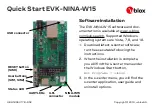DR
AFT
DR
AFT
DRAFT
DR
D
RAFT
DRAFT
DRA
FT DRAF
D
RAFT DRAFT DRAFT DRAFT DRAFT D
DRAFT
D
RAFT DRA
FT DRAFT DRAFT DRAFT DRA
UM10316_0
© NXP B.V. 2008. All rights reserved.
User manual
Rev. 00.06 — 17 December 2008
208 of 571
NXP Semiconductors
UM10316
Chapter 13: LPC29xx USB device
5. Software sends the SIE Select Endpoint command to read the Select Endpoint
Register and test the FE bit. Software finds that the active buffer (B_2) has data
(FE=1). Software clears the endpoint interrupt and begins reading the contents of
B_2.
6. The host resends the third packet which device hardware places in B_1. An endpoint
interrupt is generated.
7. Software finishes reading the second packet from B_2 and sends a SIE Clear Buffer
command to free B_2 to receive another packet. B_1 becomes the active buffer.
Software waits for the next endpoint interrupt to occur (it already has been generated
back in step 6).
8. Software responds to the endpoint interrupt by clearing it and begins reading the third
packet from B_1.
9. Software finishes reading the third packet from B_1 and sends a SIE Clear Buffer
command to free B_1 to receive another packet. B_2 becomes the active buffer.
10. Software tests the FE bit and finds that the active buffer (B_2) is empty (FE=0).
11. Both B_1 and B_2 are empty. Software waits for the next endpoint interrupt to occur.
The active buffer is now B_2. The next data packet sent by the host will be placed in
B_2.
The following example illustrates how double buffering works for a Bulk IN endpoint in
Slave mode:
Assume that both buffer 1 (B_1) and buffer 2 (B_2) are empty and that the active buffer is
B_1. The interrupt on NAK feature is enabled.
1. The host requests a data packet by sending an IN token packet. The device responds
with a NAK and generates an endpoint interrupt.
2. Software clears the endpoint interrupt. The device has three packets to send.
Software fills B_1 with the first packet and sends a SIE Validate Buffer command. The
active buffer is switched to B_2.
3. Software sends the SIE Select Endpoint command to read the Select Endpoint
Register and test the FE bit. It finds that B_2 is empty (FE=0) and fills B_2 with the
second packet. Software sends a SIE Validate Buffer command, and the active buffer
is switched to B_1.
4. Software waits for the endpoint interrupt to occur.
5. The device successfully sends the packet in B_1 and clears the buffer. An endpoint
interrupt occurs.
6. Software clears the endpoint interrupt. Software fills B_1 with the third packet and
validates it using the SIE Validate Buffer command. The active buffer is switched to
B_2.
7. The device successfully sends the second packet from B_2 and generates an
endpoint interrupt.
8. Software has no more packets to send, so it simply clears the interrupt.
9. The device successfully sends the third packet from B_1 and generates an endpoint
interrupt.
10. Software has no more packets to send, so it simply clears the interrupt.


















